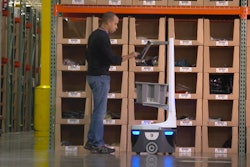By Mitch Rosenberg
Everyone expects an investment in automation to have operational benefits: reduced operating costs, increased order accuracy, faster cycle time. But one kind of automation also offers an unexpected strategic side effect: radically improved employee attraction and retention rates. For many distribution centers where scarcity of qualified workers is among the most serious challenges, a significantly improved work environment is the big and unexpected prize in the Cracker Jack box.
Mobile robotic order fulfillment systems that automate the complete spectrum of store, move and sort functions were first deployed in mainstream distribution centers several years ago. Leading companies such as Staples, Walgreens and Zappos invested in mobile order fulfillment systems instead of conventional automation such as conveyor, carousel or sortation because the new technology offers measurably superior operational performance metrics, and because robotic systems are more flexible in handling changes in product types and adapting to shifts in order volume. But after installation, these companies were pleasantly surprised by the big impact of robotic automation on worker satisfaction.
It's not obvious that employees would consider the specific type of automation in their work environment to be particularly important, but conversations with operators at DCs across the country prove otherwise. Warehouse workers agree on several reasons that they strongly prefer the work environment that results from mobile robotic automation.
The most frequently cited reason that associates prefer mobile order fulfillment systems is that they experience less physical fatigue. The inventory and orders do all the "walking" because they are carried by robotic drive units, so associates can stand still during work.
Associates also mentioned several reasons that robots reduce mental fatigue during work. For example, unlike the airport runway levels of noise in a warehouse outfitted with conventional automation, the noise level in a robot-equipped warehouse is low enough to allow conversation at ordinary voice loudness. Workers also report less mental stress in this environment because they no longer need to memorize pick paths, inventory locations and many other details. And the parallel process workflow of a robot-equipped warehouse frees workers from having to conform to the pace of their peers, reducing frustration between employees.
The work autonomy afforded by a mobile robot system gives associates another reason to seek out these workplaces: a sense of personal accomplishment. Because the robots enable each worker to independently complete each order he or she works on, associates report an increased sense of ownership of the result – ownership of the order quality as well as the speed with which they fill the orders. Worker independence also lets associates take breaks at will rather than having to schedule breaks so that other workers are not affected. In a robotic automation environment, the work automatically migrates to other team members when an associate is on break, so high-priority orders stay on track.
It is well known that most warehouse accidents occur under conditions of elevated stress, physical tiredness and frustration. So it is no surprise that a workplace with reduced physical fatigue and mental stress is also a safer workplace. And, indeed, safety record improvement is another unexpected bonus reported at robot-equipped distribution centers. In these workplaces, stressors are reduced because workers don't walk, are independently in control of their own work and enjoy a quiet environment. Since workers stand still, they don't have to risk walking in zones with high fork truck traffic. Finally, robots ensure adherence to standard operating procedures, so associates are less likely to try risky and unapproved maneuvers.
In the end, none of these improvements to the work environment are as important or hard to measure as the sense of fun that associates attribute to working with robots. The ordinary job seems to be easier to learn and more exciting to do when working with robots. Workers sometimes compete with each other for speed and accuracy records, and some describe work as if it were a video game. Many facilities report enthusiastic participation in "robot adoption programs" in which workers put a nickname sticker on "their" robot, have photos taken with them and "visit" with them regularly.
How significant is employee preference for mobile robotic automation? It's a big enough factor that Staples used video clips of the robot system in action as the centerpiece of a local cable channel recruiting advertisement. Many DC workers who have worked with robots now say that they would avoid working at a distribution center with ordinary automation or workflows. For many companies, the ability to compete effectively for the best workforce turns out to have as much impact on their success as the reduction of operational costs – a welcome surprise indeed.


















